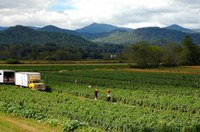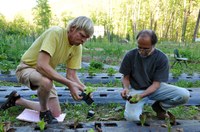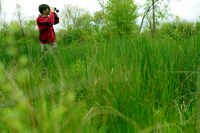Economics and Business
Economic activities depend on, and impact, nature’s productivity
The primary economic activities of a region are closely intertwined with how communities interact with their natural surroundings. Just as demographic and cultural factors influence how people benefit from nature, economies influence the utilization of—and impacts on—natural areas and resources. Economic data contained in documents such as environmental assessments, resource demand assessments, and carbon footprint reports are all clearly connected to land management and ecosystem services.
On one hand, factors such as wealth and employment influence the abilities of people to benefit from outdoor recreation opportunities and other amenity uses of Appalachian natural areas. The ways in which people utilize forests and agricultural lands can also reflect cultural preferences, which are themselves strongly related to economic factors.
On the other hand, economic activities in rural Appalachia—such as surface mining and other forms of energy development—are dramatic drivers of landscape change. These activities can provide economic anchors in rural areas, but they can also be regionally associated with entrenched poverty and even population decline. Other economic activities such as forestry and outdoor recreation and tourism do impact the natural environment, but they also depend on the maintenance of functioning ecosystems. Less obvious aspects of economic activity, such as infrastructure connectivity, also impact natural resource use and sustainability.
Many businesses use and affect ecosystem services directly. One premier example in Appalachia is water use—for example, water quality is very important to the brewing industry, but brewery effluent and water treatment after use can cause pollution. Unless companies make an effort otherwise, they may enjoy free ecological services like clean water production while ignoring costs that the landscape around them also absorbs for free. Waste disposal directly into local environments has historically been a popular and inexpensive strategy for many industries, with outcomes for human and natural communities ranging from trivial to highly detrimental.
Mediating or even participating in the development of individual company conservation policies is a key opportunity for conservation stakeholders. Industry increasingly recognizes the value of this relationship, given their dependence on sustainable ecosystem services such as clean water, timber and nontimber forest products, and natural landscapes that attract outdoor recreation and tourism.
|
Demographics and
|
Economics and Business
|
|
References
Abt, K. L. 2013. Employment and income trends and projections for forest-based sectors in the U.S. South, Chapter 12, 293–308. In D. N. Wear and J. G. Greis, editors, The Southern Forest Futures Project: Technical Report. Gen. Tech. Rep. SRS-178, USDA Forest Service, Southern Research Station: 542 pp.
Bowker, J. M., and A. Askew. 2013. Outlook for outdoor recreation in the northern United States. A technical document supporting the Northern Forest Futures Project with projections through 2060. Gen. Tech. Rep. NRS-120. USDA Forest Service, Northern Research Station: 62 pp.
Bowker, J. M., A. Askew, H. K. Cordell, and J. C. Bergstrom. 2013. Outdoor recreation, Chapter 8, 161–182. In D. N. Wear and J. G. Greis, editors, The Southern Forest Futures Project: Technical Report. Gen. Tech. Rep. SRS-178, USDA Forest Service, Southern Research Station: 542 pp.
Chamberlain, J. L. 2006. Conserving the Appalachian medicinal plant industry, 5–16. In Proceedings, Fourth Annual Symposium on Appalachian Opportunities - Medicinal and Aromatic Plants, Beckley, WV, 16–17 September 2005.
Chamberlain, J. L., S. Prisley, and M. McGuffin. 2013. Understanding the relationships between American ginseng harvest and hardwood forests inventory and timber harvest to improve co-management of the forests of eastern United States. Journal of Sustainable Forestry 32(6): 605–624.
Cho, S.-H., N. C. Poudyal, and R. K. Roberts. 2008. Spatial analysis of the amenity value of green open space. Ecological Economics66(2–3): 403–416.
Cordell, H. K., C. J. Betz, and S. H. Mou. 2013. Outdoor recreation in a shifting societal landscape, Chapter 7, 123–160. In D. N. Wear and J. G. Greis, editors, The Southern Forest Futures Project: Technical Report. Gen. Tech. Rep. SRS-178, USDA Forest Service, Southern Research Station: 542 pp.
Cordell, H. K., C. J. Betz, S. H. Mou, and D. D. Gormanson. 2012. Outdoor recreation in the Northern United States. Gen. Tech. Rep. NRS-100. USDA Forest Service, Northern Research Station: 74 pp.
Duncan, C. M., and N. Lamborghini. 1994. Poverty and social context in remote rural communities. Rural Sociology 59(3): 437–461.
Evans, J. S., and J. M. Kiesecker. 2014. Shale gas, wind and water: Assessing the potential cumulative impacts of energy development on ecosystem services within the Marcellus Play. PLOS ONE 9.
Fillaudeau, L., P. Blanpain-Avet, and G. Daufin. 2006. Water, wastewater and waste management in brewing industries. Journal of Cleaner Production 14(5): 463–471.
Hanson, C., L. Yonavjak, C. Clarke, S. Minnemeyer, L. Boisrobert, A. Leach, and K. Schleeweis. 2010. Southern Forests For the Future.World Resources Institute, Washington, D.C.: 73 pp.
Jackson, L. E., B. Rashleigh, and M. E. McDonald. 2012. Economic value of stream degradation across the central Appalachians.Journal of Regional Analysis and Policy 42(3): 188–197.
Keyser, T., J. Malone, C. Cotton, and J. Lewis. 2014. Outlook for Appalachian-Cumberland forests: a subregional report from the Southern Forest Futures Project. General Technical Report SRS-GTR-188. USDA Forest Service, Southern Research Station: 83 pp.
Lal, P., J. R. R. Alavalapati, and E. Mercer. 2011. Socio-economic impacts of climate change on rural United States. Mitigation and Adaptation Strategies for Global Change 16(7): 819–844.
Matthews, S. N., L. R. Iverson, M. P. Peters, A. M. Prasad, and S. Subburayalu. 2014. Assessing and comparing risk to climate changes among forested locations: implications for ecosystem services. Landscape Ecology 29(2): 213–228.
Merricks, T. C., D. S. Cherry, C. E. Zipper, R. J. Currie, and T. W. Valenti. 2007. Coal-mine hollow fill and settling pond influences on headwater streams in southern West Virginia, USA. Environmental Monitoring and Assessment 129(1): 359–378.
Shifley, S. R., F. X. Aguilar, N. Song, S. I. Stewart, D. J. Nowak, D. D. Gormanson, W. K. Moser, S. Wormstead, and E. J. Greenfield. 2012. Forests of the Northern United States. Gen. Tech. Rep. NRS-90, USDA Forest Service, Northern Research Station: 202 pp.
Southern Appalachian Man and the Biosphere (SAMAB). 1996. The Southern Appalachian Assessment: Social, Cultural, and Economic Technical Report. Report 4 of 5, USDA Forest Service, Southern Region: 228 pp.
U.S. Department of Agriculture Forest Service. 2011. National Report on Sustainable Forests—2010. FS-979. USDA Forest Service: 214 pp.
Wear, D. N., and J. G. Greis, editors. 2013. The Southern Forest Futures Project: Technical Report. Gen. Tech. Rep. SRS-178, USDA Forest Service, Southern Research Station: 542 pp.
Wickham, J., P. B. Wood, M. C. Nicholson, W. Jenkins, D. Druckenbrod, G. W. Suter, M. P. Strager, C. Mazzarella, W. Galloway, and J. Amos. 2013. The overlooked terrestrial impacts of mountaintop mining. BioScience 63(5): 335–348.
Wickham, J. D., K. H. Riitters, T. G. Wade, M. Coan, and C. Homer. 2007. The effect of Appalachian mountaintop mining on interior forest. Landscape Ecology 22(2): 179–187.




























